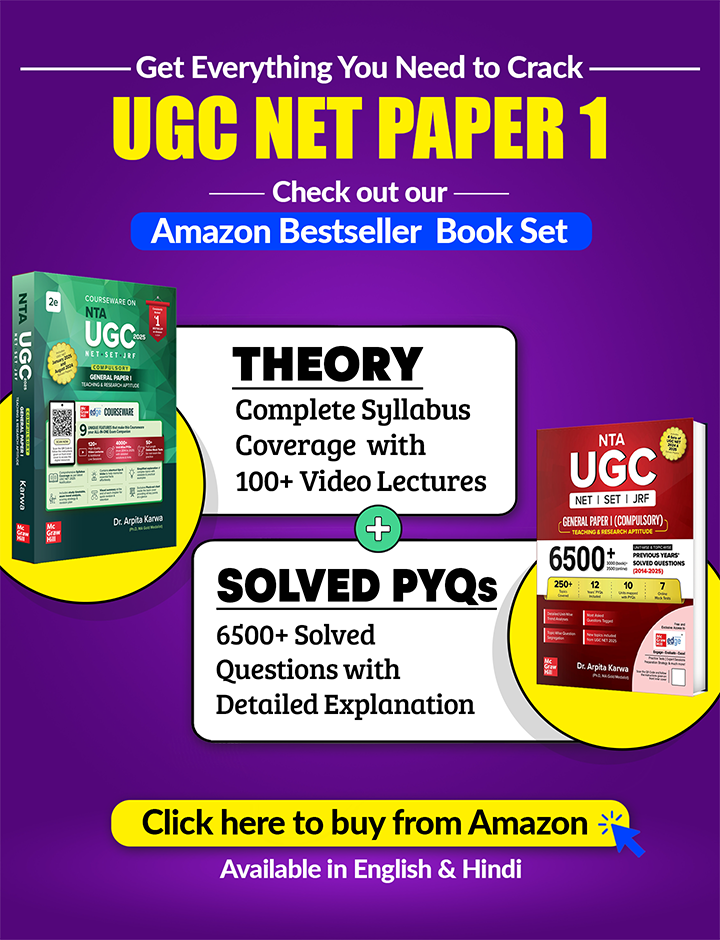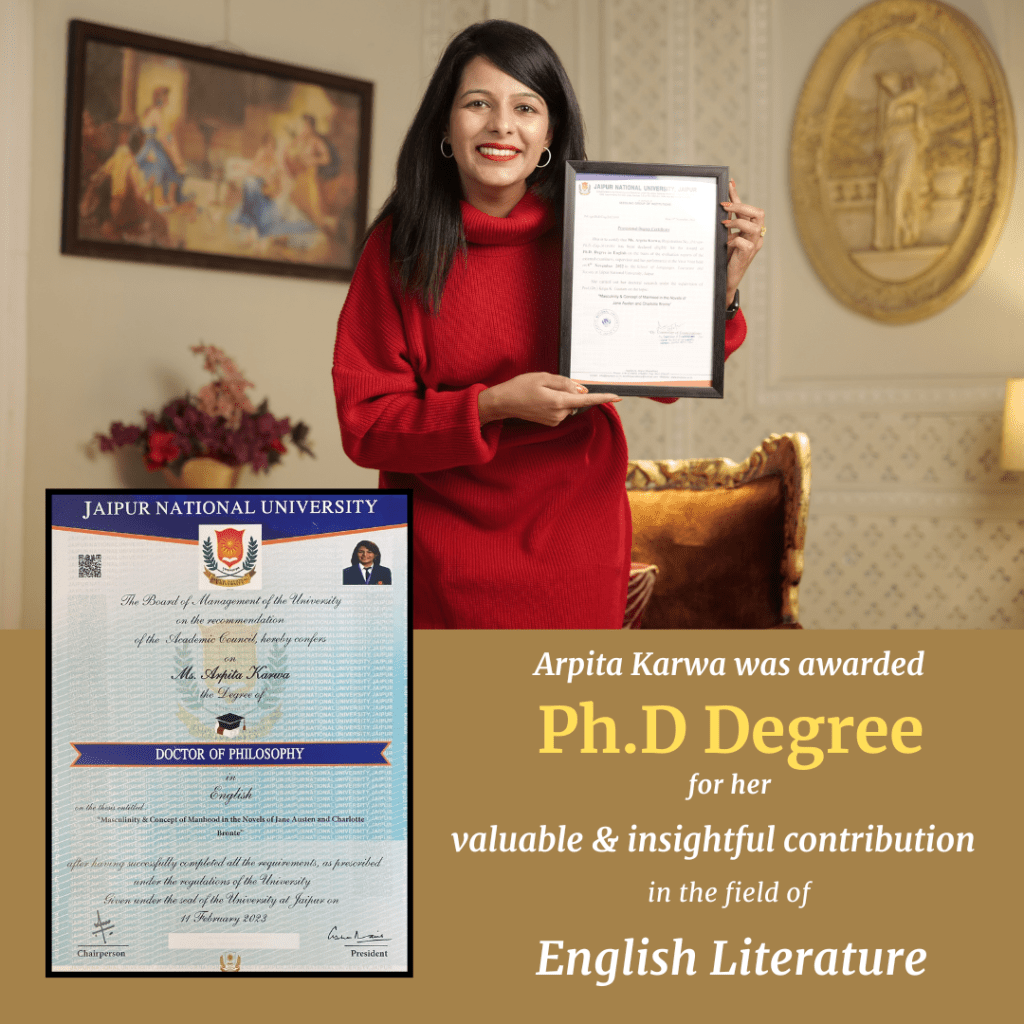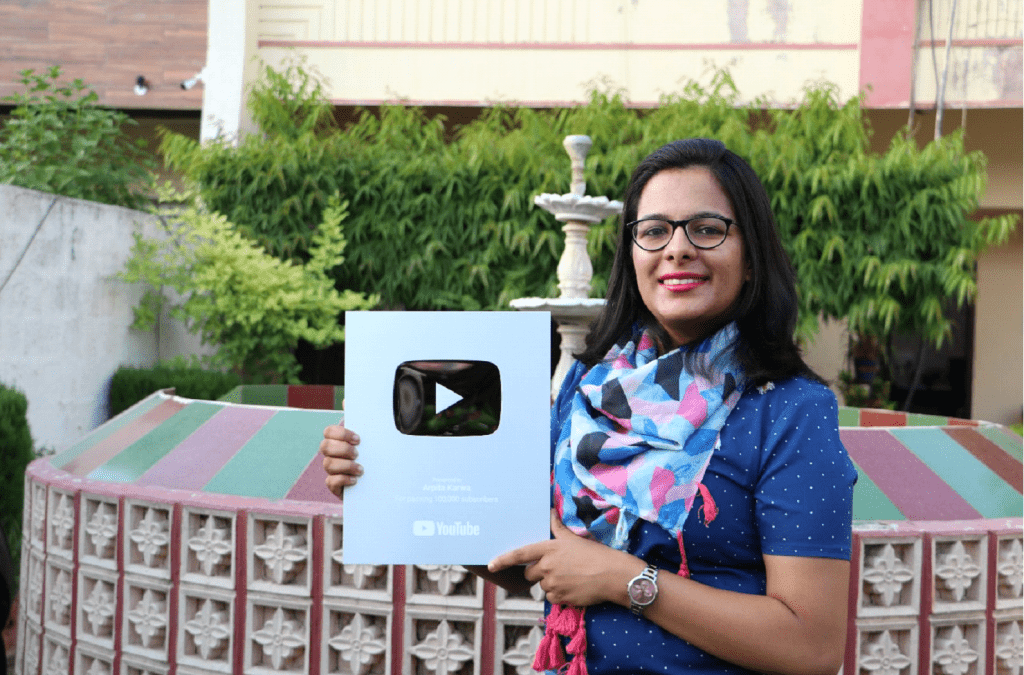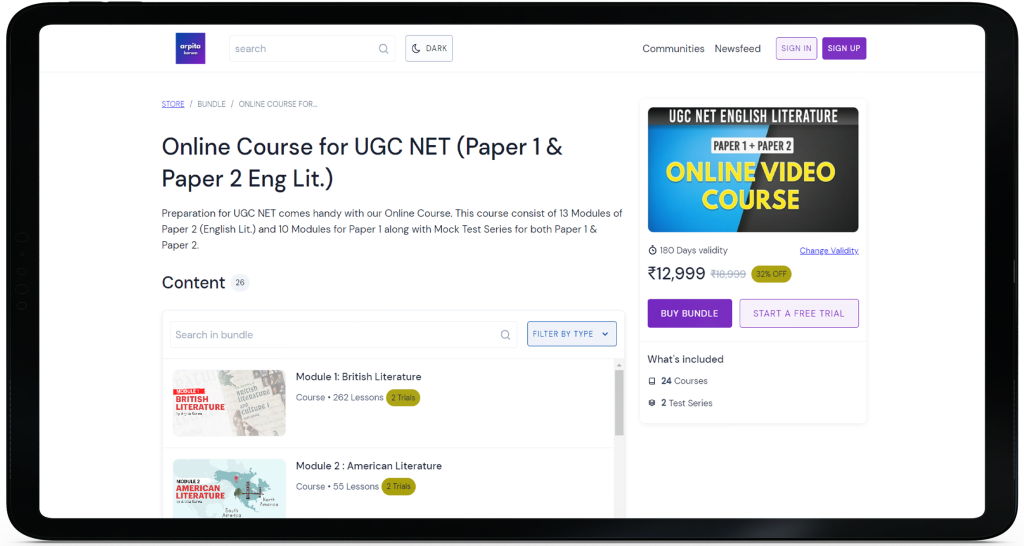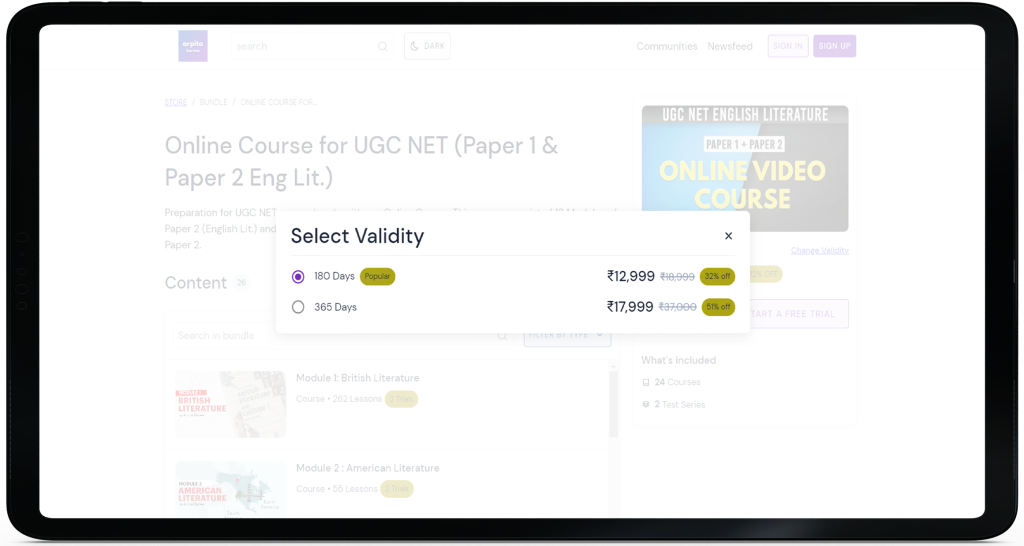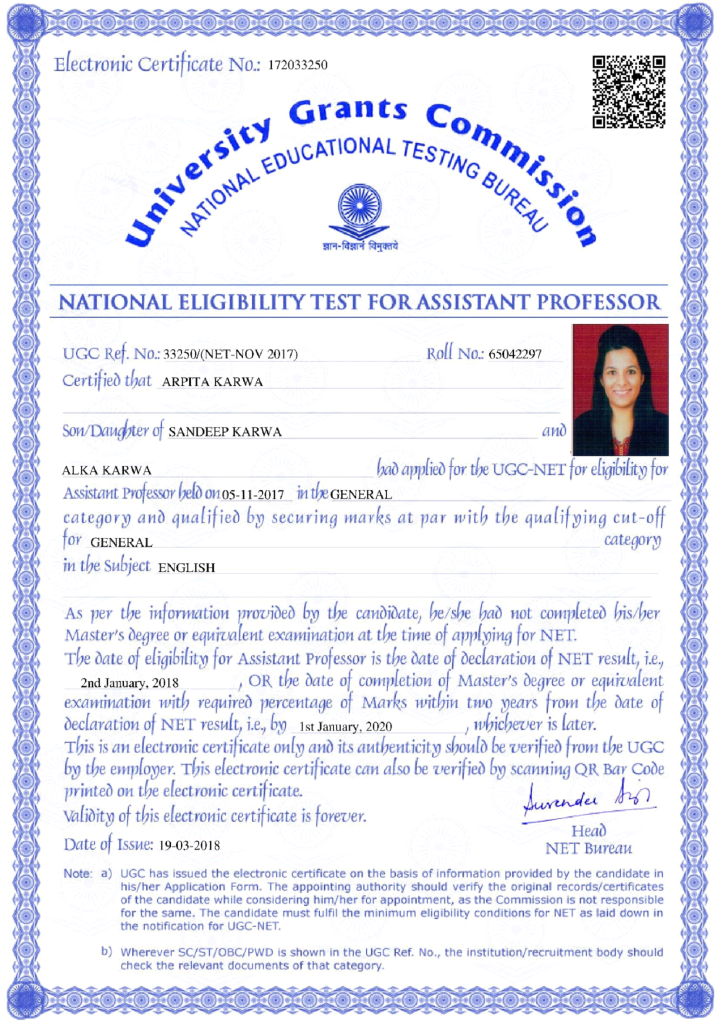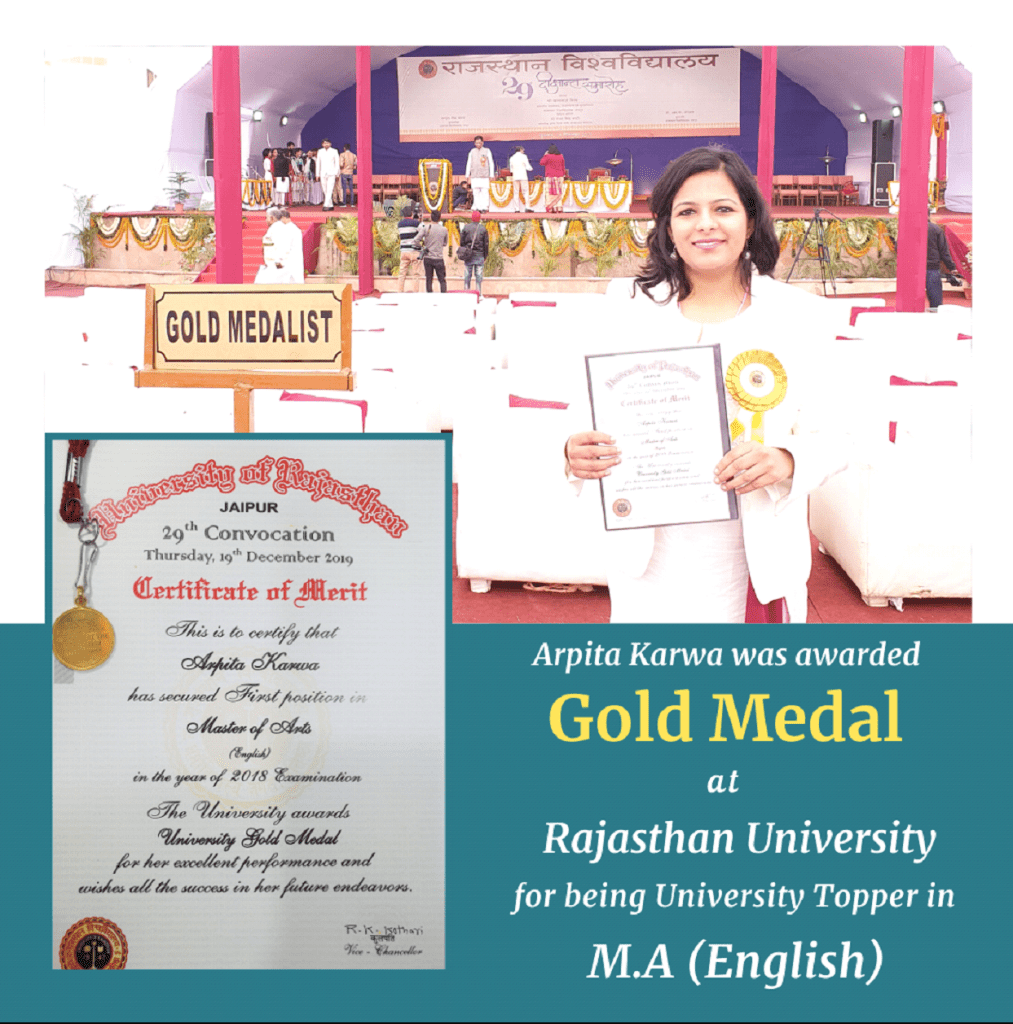December 2021: Paper 2 (Conducted on 1st Dec 2021 : Morning Shift)
June 19, 2023 2025-10-13 14:14December 2021: Paper 2 (Conducted on 1st Dec 2021 : Morning Shift)
December 2021: Paper 2 (Conducted on 1st Dec 2021 : Morning Shift)
Q.1-3)
Q.1) In the context of the above which is closest to being true?
[1] There can be no use of poetry.
[2] Poetry can have no true subject.
[3] Man may be the true subject of poetry.
[4] The poet himself may be the subject.
Answer – [4]
Q.2) What is meant by ‘traditional use of poetry’?
[1] Promoting serious ideas
[2] Promoting doubtful pleasure
[3] Promoting joyous expectations
[4] Promoting social honesty in life
Answer – [3]
Q.3) If ‘selfhood’ of a poet is the subject of poetry, then ‘originality’ shall spring from:
[1] some truth of untruths.
[2] truth of self-recognition.
[3] creating ideal pleasures.
[4] re-living the past joys.
Answer – [1]
Q.4-6)
Q.4) Which of the following best describes the meaning of the title of the poem, ‘No worst, there is none’?
[1] It is not worst because there is nothing.
[2] Nothing can be so much bad as this.
[3] No it is worst s nothing is there.
[4] It is very bad as no one is there.
Answer – [2]
Q.5) Beyond the intensity of known grief, there can be:
[1] no grief than being experienced.
[2] only a new pain more painful.
[3] only the twisted known pains.
[4] the griefs beyond limits of pain.
Answer – [3]
Q.6) Which two of the following are true?
A. Not all know the intensity or depth of suffering.
B. Death does not put an end to our sufferings.
C. Suffering is seen as winds that hinder comfort.
D. Suffering’s intensity or depth is in the mind.
[1] A and B only
[2] C and D only
[3] A and D only
[4] B and D only
Answer – [3]
Q.7-8)
Read the following extract and answer the questions that follow:
“Justice was done, and the President of the Immortals in Aschean phrase, had ended his Sport with Tess. And the ‘Ubervil knights and dames slept on their tombs unknowing.
The two speechless gazers bent themselves down to the earth, as if in prayer, and remained thus a long time, absolutely motionless; the flag continued to wave silently. As soon as they had enough strength they arose, joined hands again, and went on.
– Thomas Hardy, Tess of the D’Urbervilles
Q.7) How did the “sport with Tess” end?
[1] She was hanged.
[2] She was expelled from Wintoncester.
[3] The tormentor married her.
[4] She died an untimely death.
Answer – [1]
Q.8) Who are the ‘two speechless gazers’?
[1] Reverend James Clare and Mrs. Brooks
[2] Liza-Lu and Angel Clare
[3] Tess’s two parents
[4] Parson Tringham and M. dUrberville
Answer – [2]
Q.9-10)
“The solemn temples, the great globe itself,
Yea, all which it inherit, shall dissolve
And, like this insubstantial pageant faded,
Leave not a rack behind. We are such stuff
As dreams are made on, and our little life
Is rounded with a sleep.
~ Shakespeare, The Tempest
Q.9) This insubstantial pageant’ refers to:
[1] the shutdown of Globe theatre.
[2] a non-real performance.
[3] the destroyed mother earth.
[4] enactment with support structure.
Answer – [2]
Q.10) “We are such stuff as dreams are made on’ means:
[1] Human life s full of imaginary colours.
[2] Our life s a text of what happened.
[3] We are a bundle of past reality.
[4] There is no substance to human life.
Answer – [4]
Q.11) In “An Apology or Poetry” Sidney discusses the didactic function of poetry by comparing it to philosophy and:
[1] religion.
[2] aesthetics.
[3] history.
[4] ethics.
Answer – [3]
Q.12) According to Longinus which two of the following qualities apply to ‘great poetry’?
A. It must be the work of genius, an inspired person.
B. It must cause a feeling of melancholy in the reader.
C. It must employ devices of rhetoric.
D. It must please selectively and on special occasions.
[1] A and B only
[2] A and C only
[3] B and D only
[4] C and D only
Answer – [2]
Q.13) In “The Function of Criticism” T.S.Eliot attacked J. Middleton Murry and similar critics for being devotees of what he called:
[1] “the Inner Voice.
[2] “the Romantic Impulse”.
[3] “the Symbol Hunt”.
[4] “the Muse’s Mystery”.
Answer – [1]
Q.14) Who among the following compared ‘the mind in creation’ to ‘a fading coal’?
[1] Wordsworth
[2] Coleridge
[3] Shelley
[4] Keats
Answer – [3]
Q.15) Who among the following considered paraphrase as ‘a heresy’?
[1] Percy Lubbock
[2] Edmund Wilson
[3] I.A.Richards
[4] Cleanth Brooks
Answer – [4]
Q.16) Empiricist linguistics is concerned with :
[1] investigation of the human mind.
[2] directly observable sense-data.
[3] reason as a determinant of enquiry.
[4] innate language knowledge.
Answer – [2]
Q.17) In Noam Chomsky’s definition of grammar which two features are drawn from mathematics?
A. complexity
B. abstraction
C. transformation
D. generation
[1] A and B only
[2] A and C only
[3] B and D only
[4] C and D only
Answer – [4]
Q.18) ‘Potato’ is a sixteenth-century borrowing into English from:
[1] Spanish.
[2] French.
[3] German.
[4] Norwegian.
Answer – [1]
Q.19) Who among the following represents the global spread of English diagrammatically as three concentric circles?
[1] David Crystal
[2] Jenny Cheshire
[3] Braj B. Kachru
[4] Salikoko Mufwene
Answer – [3]
Q.20) Who among the following is the founder of the Survey of English Usage (SEU)?
[1] Randolph Quirk
[2] Henry Watson Fowler
[3] Michael Swan
[4] Bryan Gamer
Answer – [1]
Q.21) Who is the author of the short story, “Beethoven Was One-Sixteenth Black”?
[1] J. M. Coetzee
[2] Nadine Gordimer
[3] Andre Brink
[4] Bessie Head
Answer – [2]
Q.22) Arrange the following texts in the chronological order of publication.
A. This Bridge Called My Back
B. Sexual Politics
C. Gender Trouble
D. The Feminine Mystique
[1] B, D, A, C
[2] D, B, A, C
[3] D, A, B, C
[4] B, D, C, A
Answer – [2]
Q.23) Who is the author of the essay “Lear, Tolstoy and the Fool”?
[1] Aldous Huxley
[2] George Orwell
[3] Virginia Woolf
[4] Somerset Maugham
Answer – [2]
Q.24) Which of the following poems by Robert Browning contains the lines, “Our interest’s on the dangerous edge of things.
The honest thief, the tender murderer, The superstitious atheist. . .”?
[1] “A Death in the Desert”
[2] “Count Gismond”
[3] “Bishop Blougram’s Apology”
[4] “Love Among the Ruins”
Answer – [3]
Q.25) Who among the following edited The Cornhill Magazine:
[1] Charles Dickens
[2] Lewis Carroll
[3] William Makepeace Thackeray
[4] Anthony Trollope
Answer – [3]
Q.26) Which of the following novels has its epigraph taken from the Katha Upanishad?
[1] The island of Doctor Moreau by H. G. Wells
[2] The Razor’s Edge by Somerset Maugham
[3] Point Counter Point by Aldous Huxley
[4] A Room with a View by E. M. Forster
Answer – [2]
Q.27) Who is the author of the essay, “What Isn’t Literature?”
[1] E.D. Hirsch Jr.
[2] Paul Ricoeur
[3] Hans-Georg Gadamer
[4] Terry Eagleton
Answer – [1]
Q.28) Erich Auerbach’s Mimesis (1946) ends with a chapter on:
[1] Virginia Woolf’s To the Lighthouse.
[2] Wyndham Lews’s The Apes of God.
[3] James Joyce’s Ulysses.
[4] George Eliot’s Middlemarch.
Answer – [1]
Q.29) Which of the following clusters is associated with what Julia Kristeva terms the ‘semiotic’?
[1] Authority, order and patriarchy
[2] Displacement, slippage and condensation
[3] Repression, control and normalcy
[4] Logic, reason and power
Answer – [2]
Q.30) Which two works in the following list are written by Aphra Behn?
A. Rover
B. Oroonoko
C. Soldier’s Fortune
D. The Princess of Cleve
[1] A and B only
[2] B and C only
[3] B and D only
[4] A and C only
Answer – [1]
Q.31) Which two of the following are works by Gustave Flaubert?
A. The Temptation of Saint Anthony
B. 0ld Goriot
C. Therese Raquin
D. Sentimental Education
[1] A and C only
[2] B and C only
[3] A and D only
[4] B and D only
Answer – [3]
Q.32) Which two of the following conform to liberal humanist thought?
A. Literature transcends the limits of the age of its origin and so is timeless.
B. Literature is untouched by the essential human nature which is unchanging.
C. Literature is devoid of any purpose to enhance life or promote human values.
D. Identity is a unique essence unaffected by environment and society.
[1] A and C only
[2] B and C only
[3] A and D only
[4] B and D only
Answer – [3]
Q.33) Which two of the following conform to Northrop Frye’s typology of literature?
A. Mythos of spring: Comedy
B. Mythos of summer: Satire
C. Mythos of autumn: Tragedy
D. Mythos of winter: Romance
[1] A and B only
[2] B and D only
[3] A and C only
[4] B and D only
Answer – [3]
Q.34) Which two of the following writers does A. D. Hope address through his poetic responses in A Book of Answers?
A. Tolstoy
B. Dostoevsky
C. Mallarme
D. Goethe
[1] A and D only
[2] B and C only
[3] B and D only
[4] A and C only
Answer – [4]
Q.35) Which two of the following are true according to the documentation style prescribed by the eighth edition of the MLA Handbook?
A. If the title page of a book contains an imprint as well as the publisher’s name, omit the imprint and use the publisher’s name.
B. While giving a URL copy it from the Web browser but omit http:// or https://.
C. If a quotation extends to more than five lines set it off from the text as block indented an inch from the left margin.
D. Long titles should be abbreviated using the first letter of key words typed in upper case without intervening space.
[1] A and B only
[2] A and C only
[3] B and C only
[4] B and D only
Answer – [1]
Q.36) Which two of the following are highlighted in relation to specific historical moments by Stephen Greenblatt?
A. crisis of meaning
B. circulation of meaning
C. production of meaning
D. deferral of meaning
[1] A and B only
[2] B and C only
[3] C and D only
[4] B and D only
Answer – [2]
Q.37) Who among the following belongs to the Chicago School of Critics?
A. R.S. Crane
B. E. M. W. Tillyard
C. Elder Olson
D. Allen Tate
[1] A and C only
[2] A and D only
[3] B and C only
[4] B and D only
Answer – [1]
Q.38) Which of the following poems contains John Donne’s famous conceit bringing a parallel between lovers and the hands of a compass?
[1] “Negative Love”
[2] “Lovers Infinitenesse”
[3] “A Valediction: Forbidding Mourning”
[4] “A Valediction: Of Weeping”
Answer – [3]
Q.39) Arrange the following essays in the chronological order of publication.
A. T.S. Eliot, “The Function of Criticism”
B. Edgar Allan Poe, “The Philosophy of Composition”
C. Henry James, “The Art of Fiction”
D. Virginia Woolf, “Modern Fiction”
[1] C, B, A, D
[2] C, B, D, A
[3] B, C, D, A
[4] B, C, A, D
Answer – [3]
Q.40) Assertion A : Postmodern narratives focus on the indeterminate and unstable nature of textuality and subjectivity.
Reason R: Postmodern narrative acts regard narratives and characters as tentative representations of writing and identity.
[1] Both A and R are true and R is the correct explanation of A
[2] Both A and R are true but R is NOT the correct explanation of A
[3] A ls true but R is false
[4] A is false but R s true
Answer – [1]
Q.41) Statement I: In Waiting for Godot, it is Vladimir who questions the Boy who comes from Godot towards the end of the two Acts.
Statement II: In Waiting for Godot, it is Estragon who says, “Nothing happens, nobody comes, nobody goes, it’s awful.”
[1] Both Statement | and Statement Il are true
[2] Both Statement | and Statement Il are false
[3] Statement I is true but Statement Il is false
[4] Statement I is false but Statement II is true
Answer – [1]
Q.42) Statement I: New Historicism stipulates that teleological connotations of history have to be eschewed.
Statement II: New Historicism neither denies nor accepts totalizing explanations of historical events.
[1] Both Statement I and Statement Il are true
[2] Both Statement I and Statement II are false
[3] Statement I is true but Statement II is false
[4] Statement I is false but Statement Il is true
Answer – [3]
Q.43) What was poor Yorick in Hamlet?
[1] Jester
[2] Actor
[3] Soldier
[4] Gravedigger
Answer – [1]
Q.44) Which of the following words refers to a sound that is associated with a particular meaning?
[1] phoneme
[2] phonic substance
[3] phonestheme
[4] phonemoid
Answer – [3]
Q.45) Who among the following Dickens characters appears as a ghost?
[1] Daniel Quilp
[2] Dora Spenlow
[3] Esther Summerson
[4] Jacob Marley
Answer – [4]
Q.46) Virginia Woolf’s Orlando opens in 1588 and Orlando, a sixteen-year-old boy, writes a poem called:
[1] “The Evergreen Tree”.
[2] “The Poison Tree”.
[3] “The Oak Tree”.
[4] “The Magic Tree”.
Answer – [3]
Q.47) What function of English is exemplified by the use of English in India as a “link language” along with a first language by stable bilinguals in well-defined social contexts?
[1] complementary
[2] supplementary
[3] auxiliary
[4] equative
Answer – [1]
Q.48) Who among the following is said to have believed that the Persian Gulf War (1990-91) never happened?
[1] Zygmunt Bauman
[2] Jean Baudrillard
[3] Jacques Derrida
[4] Jurgen Habermas
Answer – [2]
Q.49) What 19th-century philosophical term of Russian origin did Friedrich Nietzsche use to describe the disintegration of traditional morality in Western society?
[1] absolutism
[2] cynicism
[3] nihilism
[4] anarchism
Answer – [3]
Q.50) Which of the following statements is true of the working group set up by the University Grants Commission in 1978 to study the medium of instruction in higher education?
[1] It recommended a quicker switchover of the medium of Instruction from English to Indian languages.
[2] It observed that English need not be displaced as the medium of instruction although regional Languages were quite ready to take over its functions.
[3] It argued that English s a highly developed language was best suited for India’s industrial and scientific progress.
[4] It asserted that English had the potential to further polarize an already-divided nation along socio-economic and intellectual fault lines.
Answer – [3]
Q.51) In comparative philology and sometimes in modern phonology, what is the term used to refer to the deletion of a vowel within a word?
[1] Aphaeresis
[2] Equi-deletion
[3] Paradigm
[4] Syncope
Answer – [4]
Q.52) Which of the following statements best describes Terry Eagleton’s views on literature?
[1] It is involved in the reproduction of the dominant social order.
[2] Its raison d’étre is to reflect social reality directly.
[3] Its primary purpose is to produce beauty and pleasure.
[4] It is closely allied to religion in its significance and seriousness.
Answer – [1]
Q.53) Which of the following are true of ‘performance’, as used in linguistic theory?
A. It is analogous to the Saussurean concept of langue.
B. It refers to the specific utterances of individual native speakers in actual situations.
C. It is an innate grammar that suggests humans’ universal ability to use language.
D. It includes hesitations and unfinished structures arising out of psychological difficulties acting upon the speaker.
[1] A and B only
[2] B and C only
[3] A and C only
[4] B and D only
Answer – [4]
Q.54) Which among the following are the works of George Gissing?
A. New Grub Street
B. Agnes Grey
C. The Odd Women
D. Mary Barton
[1] A and C only
[2] B and D only
[3] A and B only
[4] C and D only
Answer – [1]
Q.55) Which of the following are novels by lan McEwan?
A. Atonement
B. The Man with Two Left Feet
C. The Child in Time
D. The Rachel Papers
[1] A and C only
[2] B and D only
[3] C and D only
[4] D and A only
Q.56) Which of the following are poems by Nissim Ezekiel that make fun of Indians’ use of English?
A. “Goodbye Party for Miss Pushpa T.S.”
B. “Philosophy”
C. “Very Indian Poem in Indian English”
D. “Jewish Wedding in Bombay”
E. “Poet, Lover, Birdwatcher”
[1] A and C only
[2] B and D only
[3] A, B and D only
[4] A, C and E only
Answer – [1]
Q.57) Match List I with List Il
LIST I (Author)
A. Sean O’ Casey
B. Dylan Thomas
C. Terence Rattingan
D. Arnold Wesker
E. J.M.Synge
LIST II (Text)
I. I’m Talking About Jerusalem
II. The Winslow Boy
III. Juno and the Paycock
IV. In the Shadow of the Glen
V. Under Milk Wood
[1] A-II, B-I, C-III, D-IV, E-IV
[2] A-V, B-I, C-IV, D-II, E-III
[3] A-III, B-V, C-II, D-I, E-IV
[4] A-IV, B-II, C-III, D-I, E-I
Answer – [3]
Q.58) Match List I with List Il
LIST I (First Line)
A. “Courage!” he said, and pointed toward the land…
B. I am poor brother Lippo, by your leave!
C. I caught this morning morning’s minion….
D. Look in my face; my name is Might-have-been…
E. The sea is calm tonight…
LIST II (Poet)
I. G.M.Hopkins
II. Alfred Tennyson
III. D.G. Rossetti
IV. Matthew Arnold
V. Robert Browning
[1] A-V, B-III, C-II, D-IV, E-I
[2] A-IV, B-V, C-II, D-I, E-III
[3] A-III, B-V, C-IV, D-I, E-II
[4] A-II, B-V, C-I, D-III, E-IV
Answer – [4]
Q.59) Match List I with List Il
LIST I (Character)
A. Winston Smith
B. Paul Morel
C. ‘whiskey priest’
D. Leopold Bloom
E. Paul Pennyfeather
LIST II (Novel)
I. Sons and Lovers
II. Ulysses
III. Nineteen Eighty-four
IV. Decline and Fall
V. The Power and the Glory
[1] A-III, B-I, C-V, D-II, E-IV
[2] A-IV, B-V, C-II, D-I, E-III
[3] A-I, B-V, C-IV, D-I, E-III
[4] A-II, B-V, C-I, D-III, E-IV
Answer – [1]
Q.60) Arrange the following language areas of the human brain in the order in which they involve in hearing, understanding and saying a word:
A. arcuate fasciculus
B. anterior speech cortex
C. motor cortex
D. posterior speech cortex
[1] A, C, D, B
[2] B, A, D, C
[3] C, B, A, D
[4] D, A, B, C
Answer – [4]
Q.61) Choose the right chronological sequence of the publication of the following books:
A. Margaret Atwood, The Handmaid’s Tale
B. Alice Walker, The Color Purple
C. Doris Lessing, The Golden Notebook
D. Toni Morrison, The Bluest Eye
[1] A, B, D, C
[2] B, A, D, C
[3] C, D, B, A
[4] D, C, B, A
Answer – [3]
Q.62) Statement I: Unlike scientific research, literary research does not have specific materials for investigation and scientific tools for reaching a conclusion and formulating a theory.
Statement II: Literary research consists of critical interpretations of an author’s work to the exclusion of biography and editing of texts.
[1] Both Statement I and Statement Il are correct.
[2] Both Statement I and Statement Il are incorrect.
[3] Statement I is correct but Statement Il is incorrect.
[4] Statement I is incorrect but Statement Il is correct.
Answer – [2]
Q.63) Statement I: Linguists, being primarily interested in the scientific study of language, approach language dispassionately.
Statement II: Linguists are necessarily polyglots who bring their own biases to language study.
[1] Both Statement I and Statement Il are correct.
[2] Both Statement I and Statement Il are incorrect.
[3] Statement I is correct but Statement Il is incorrect.
[4] Statement I is incorrect but Statement Il is correct.
Answer – [3]
Q.64) Which of the following are features of the ‘Theatre of the Absurd’?
A. emphasis on the central role of God in the universe
B. presentation of futile actions devoid of any goal
C. portrayal of situations that point to the meaningfulness of life
D. lacking in conflicts and dramatic tensions
E. presenting players in a stasis or drift without definite roles
[1] A, C and E only
[2] B, D and E only
[3] A, B and D only
[4] B, C and D only
Answer – [2]
Q.65) Who, among the following, is known to have used elements from the Yakshagana tradition in his theatre?
[1] Badal Sircar
[2] Girish Karnad
[3] Mohan Rakesh
[4] Mahesh Dattani
Answer – [2]
Q.66) Match List I with List Il
LIST I (Writer)
A. Bankimchandra Chatterjee
B. Mulk Raj Anand
C. Panchkouree Khan
D. Kamala Sathianadhan
LIST II (Book)
I. Untouchable
II. Rajmohan’s Wife
III. Stories from Indian Christian Life
IV. The Revelations of an Orderly
[1] A-II, B-I, C-IV, D-III
[2] A-I, B-IV, C-III, D-II
[3] A-II, B-III, C-IV, D-I
[4] A-IV, B-I, C-II, D-III
Answer – [1]
Q.67) Which of these UK universities saw the first institutional incorporation of Cultural Studies?
[1] Bath Spa University.
[2] Oxford University
[3] University of Birmingham
[4] Cambridge University
Answer – [3]
Q.68) Which of these poets wrote a poem that served to inspire W B Yeats to write his own poem, “When you are Old”?
[1] Francois Villon
[2] Pierre de Ronsard
[3] Edmund Spencer
[4] Heinrich Heine
Answer – [2]
Q.69) Which of these does Meenakshi Mukherjee propose as the possible target readership of early Indian English novel?
A. A pan-Indian readership
B. A localized Indian readership
C. A British readership
D. The colonial administrator in India
[1] A and B only
[2] B and C only
[3] C and D only
[4] A and D only
Answer – [3]
Q.70) Match List I with List Il
LIST I (Poet)
A. Charles Baudelaire
B. Heinrich Heine
C. Sylvia Plath
D. Jose Marti
LIST II (Language)
I. French
II. German
III. English
IV. Spanish
[1] A-I, B-II, C-III, D-IV
[2] A-I, B-IV, C-III, D-II
[3] A-II, B-III, C-IV, D-I
[4] A-IV, B-I, C-II, D-III
Answer – [1]
Q.71) Which of these constitute the preoccupations of the protagonist of Upamanyu Chatterjee’s English, August?
A. Marijuana
B. Magic
C. Monotheism
D. Marcus Aurelius
[1] A and B only
[2] A and D only
[3] B and C only
[4] B and D only
Answer – [2]
Q.72) What was the name of the journal published from Bowling Green University beginning 1969, which carried essays on amusement parks, comics and detective films?
[1] Journal of Mass Culture
[2] Journal of Popular Culture
[3] Journal of Public Culture.
[4] Journal of Culture Studies
Answer – [2]
Q.73) Which of these best describes Shyam Selvadurai’s novel, Funny Boy?
[1] Novel of manners
[2] Sentimental novel
[3] Coming-of-age novel
[4] Picaresque novel
Answer – [3]
Q.74) Which of these questions would Cultural Studies be most interested in asking?
A. Who decides what is to be produced?
B. Who can afford the artifact?
C. How is the artifact marketed?
D. What is the register of speech in the artifact?
[1] A, B, and C only
[2] A, C and D only
[3] B, C and D only
[4] A, B and D only
Answer – [1]
Q.75) Who, among the following, played the most significant role in mobilizing the concept of “cultural intermediaries’?
[1] Luis Althusser
[2] Karl Marx
[3] Pierre Bourdieu
[4] Jurgen Habermas
Answer – [3]
Q.76) From whom does Gayatri Chakravorty Spivak borrow the term ‘subaltern’?
[1] Karl Marx
[2] Friedrich Engels
[3] Louis Althusser
[4] Antonio Gramsci
Answer – [4]
Q.77) Which of the following does the Subaltern Studies project contend?
A. Traditional historiography celebrated the role of the subalterns.
B. Traditional history of India’s freedom movement celebrates the contribution of select icons.
C. Traditional historiography highlights the dominant strands of India’s freedom struggle.
D. Subaltern Studies historiography highlights the dominant strands of India’s freedom struggle.
[1] A and B only
[2] B and C only
[3] A and C only
[4] B and D only
Answer – [2]
Q.78) Which of these did the Wood’s Despatch (1854) seek to propagate?
A. Impart Western knowledge to Indians
B. Restrict access to English learning in India
C. Educate British officers in Sanskrit and Persian
D. Create a class of public servants
[1] A and B only
[2] B and C only
[3] A and C only
[4] A and D only
Answer – [4]
Q.79) Arrange the following periodicals in the chronological order in which they started publication:
A. The Spectator
B. The Tatler
C. The Rambler
D. The Critical Review
[1] A, B, C, D
[2] B, A, C, D
[3] B, C, D, A
[4] A, D, B, C
Answer – [2]
Q.80) Who, among these, does Gabriel Garcia Marquez name right in the beginning of his Nobel Prize address?
A. Ferdinand Magellan
B. Christopher Columbus
C. Marco Polo
D. Antonio Pigafetta
[1] A and B only
[2] B and C only
[3] C and D only
[4] A and D only
Answer – [4]
Q.81) Which of these constitutes the only extant trilogy from ancient Greek tragedy?
[1] King Oedipus, Oedipus at Colonus, Antigone
[2] Agamemnon, Choephori, The Eumenides
[3] Agamemnon, Orestes, The Eumenides
[4] King Oedipus, Orestes, Antigone
Answer – [2]
Q.82) Match List I with List Il
LIST I (Author)
A. Pinder
B. Menander
C. Sappho
D. Aristophanes
LIST II (Form)
I. Epicinia
II. Old Comedy
III. Lyric Poetry
IV. New Comedy
[1] A-IV, B-III, C-II, D-I
[2] A-I, B-IV, C-III, D-II
[3] A-II, B-III, C-IV, D-I
[4] A-IV, B-I, C-II, D-III
Answer – [2]
Q.83) Which of these does the book ‘How to read Donald Duck’ identify as an important element in its analysis of imperialist ideology in the Walt Disney comic book?
[1] impoverished royalty
[2] noble savage
[3] scientific magic
[4] heartless civilisation
Answer – [3]
Q.84) Match List I with List Il
LIST I (Play)
A. Bertolt Brecht
B. Tennessee Williams
C. Vaclav Havel
D. August Strindberg
LIST II (Playwright)
I. Cat on a Hot Tin Roof
II. Life of Galileo
III. Miss Julie
IV. Temptation
[1] A-I, B-III, C-II, D-Iv
[2] A-III, B-IV, C-II, D-I
[3] A-IV, B-III, C-II, D-I
[4] A-II, B-I, C-IV, D-III
Answer – [4]
Q.85) Which of these plays by Girish Karnad shares its theme with Thomas Mann’s The Transposed Heads?
[1] Hayavadana
[2] Yayati
[3] Nagamandala
[4] Tale Danda
Answer – [1]
Q.86) With which of these is Ngugi wa Thiongo generally associated?
[1] Decolonising the State
[2] Decolonising the Mind
[3] Decolonising the Body
[4] Decolonising the Polity
Answer – [2]
Q.87) Match List I with List Il
LIST I (Novel)
A. Don Quixote
B. Sorrows of Young Werther
C. Lotus Illusions
D. Epitaph of a Small Winner
LIST II (Author)
I. Machado de Assis
II. Honore de Balzac
III. Goethe
IV. Miguel de Cervantes
[1] A-I, B-III, C-II, D-Iv
[2] A-III, B-IV, C-II, D-I
[3] A-IV, B-III, C-II, D-I
[4] A-II, B-I, C-IV, D-III
Answer – [3]
Q.88) Charles Lamb used the pseudonym Elia for writing in which of the following periodicals?
[1] London Magazine
[2] The Edinburg Review
[3] The Quarterly Review
[4] Athenaeum
Answer – [1]
Q.89) In “Mr. Bennett and Mrs. Brown” Virginia Woolf:
[1] responds to E.M Forster’s remarks on character in fiction.
[2] criticises book buying preferences of the educated English class.
[3] analyses the state of modern fiction by contrasting two generations of writers.
[4] presents modernity as a stable and coherent project uniting all artists.
Answer – [3]
Q.90) In “Politics and the English Language” which two of the following ‘tricks’ are mentioned by George Orwell as ‘bad habits’ of English use?
A. obsolete words
B. pretentious diction
C. dying metaphors
D. false modifiers
[1] A and B only
[2] B and C only
[3] B and D only
[4] C and D only
Answer – [2]
Q.91) Match List I with List Il
LIST I (Essay)
A. “The Tory Fox- Hunter”
B. “What I Believe”
C. “The Death of the Moth”
D. “Of Ambition”
LIST II (Essayist)
I. Francis Bacon
II. Joseph Addison
III. E.M.Forster
IV. Virginia Woolf
[1] A-I, B-III, C-II, D-IV
[2] A-III, B-IV, C-II, D-I
[3] A-II, B-III, C-IV, D-I
[4] A-IV, B-I, C-II, D-III
Answer – [3]
Q.92) Arrange the following characters in their chronological sequence of appearance:
A. Mirabell
8. Shylock
C. Jimmy Porter
D. Sir Epicure Mammon
[1] D, B, A, C
[2] B, D, A, C
[3] D, B, C, A
[4] B, D, C, A
Answer – [2]
Q.93) Which two of the following concepts are deployed in the work of Frederic Jameson?
A. Pastiche
B. Hyperreal
C. Schizophrenia
D. Habitus
[1] A and B only
[2] C and D only
[3] B and D only
[4] A and C only
Answer – [4]
Q.94) Arrange the following plays in their chronological sequence:
A. Sergeant Musgrave’s Dance
B. The Playboy of the Western World
C. Look Back in Anger
D. Man and Superman
[1] D, B, A,C
[2] B, D, A, C
[3] D, B, C, A
[4] B ,D, C, A
Answer – [3]
Q.95) Match List I with List Il
LIST I
A. Modernity at Large
B. The Tourist Gaze
C. Culture and Imperialism
D. The Black Jacobins
LIST II
I. J. Urry
II. E.W. Said
III. C.L.R. James
IV. A. Appadurai
[1] A-IV, B-III, C-II, D-I
[2] A-III, B-IV, C-II, D-I
[3] A-II, B-III, C-IV, D-I
[4] A-IV, B-I, C-II, D-III
Answer – [4]
Q.96) What might the speaker mean when he addresses “Time” in a Shakespearean sonnet and declares that “I will be true, despite thy scythe and thee “?
A. Time preserves human life.
B. With time comes change.
C. Time creates opportunities.
D. Time removes human life.
[1] A and B only
[2] C and D only
[3] B and D only
[4] A and C only
Answer – [3]
Q.97) Which two of the following stage directions are from Harold Pinter’s The Birthday Party?
A. The living-room of a house on a seaside town.
B. A garbage pail on the ground next to the porch steps.
C. A light shows from upstairs bedroom, lower floor windows being dark.
D. He hangs the drum around his neck, taps it gently with the sticks, then marches round the table, beating it regularly.
[1] A and D only
[2] C and D only
[3] B and C only
[4] A and C only
Answer – [1]
Q.98) Arrange the following lines of poetry in their chronological sequence:
A. “An aged man is but a paltry thing.”
B. “The world s too much with us.”
C. “Daddy, I have had to kill you.”
D. “After great pain, a formal feeling comes –
[1] B, D, A, C
[2] D, B, A, C
[3] D, B, C, A
[4] B, D, C, A
Answer – [1]







